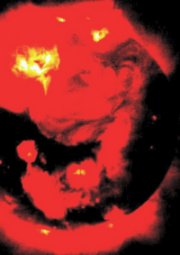
Nibiru the Messianic Star
In searching for clues to identify the last appearance of Nibiru in our skies, it is necessary to have in mind the description of this remarkable celestial entity. Sumerian accounts of the great celestial battle between Nibiru and Earth’s precursor, the watery monster Tiamat, indicate clearly its identity as a fiery hulk:
"In front of him he set the lightning,
with a blazing flame he filled his body;
He then made a net to enfold Tiamat therein…
A fearsome halo his head was turbaned,
He was wrapped with awesome terror as with a cloak." (1)
This description of Nibiru by the Sumerians appears to have a later corollary in the Biblical Book of Job, although it is not so clear that we are being told about Nibiru. Clearly, the original texts have been altered to suit the monotheistic bias of the Hebrews compiling the Bible. However, parallels are apparent between the above Sumerian text about Nibiru, and the Biblical account of the Lord's battle with the ‘sea-monster’ Leviathan:
"Its snortings throw out flashes of light; its eyes are like rays of dawn.
Burning lamps go forth from its mouth, and sparks of fire leap out.
Smoke goes forth from its nostrils as from a boiling pot or cauldron.
Its breath sets coals ablaze, and flames go forth from its mouth…"
Job 41: 18-21
From the Mesopotamian point of view, the victor was the Lord, and the defeated ‘monster’ was the watery Tiamat, the planetary precursor of the Earth. Things are less clear in the Biblical version. Nevertheless, this awesome description of the brown dwarf appears in the same text as the account of its celestial heavenly passage noted above.
Nibiru is clearly no ordinary planet. It seems surrounded by nets, halos, a cloak, lightning and flames, and this imagery described its appearance prior to the impact of one of its moons with Tiamat, ruling out these references as being explosions. They are clearly descriptions of Nibiru’s actual appearance, although possibly in an excited state. If one thinks of the corona that one sees around the Sun during a total eclipse, one can begin to grasp the meaning of these verses. This is a fiery entity whose brilliance is not great enough to blind us to its coronal discharge under normal viewing conditions. In other words, a brown dwarf. This brown dwarf has seven moons, which are poetically referred to as "winds" in the texts (literal Sumerian meaning: "Those that are by the side"):
"He sent forth the winds which he had created,
the seven of them; to trouble Tiamat within
they rose up behind him" (1)
Sitchin goes on to describe the immensely destructive effect upon Tiamat of Nibiru’s close passage. Note that Tiamat must have been a considerably larger planet than the Earth, which is understood, from the texts, to have formed from the cleaving of Tiamat in half. So Nibiru must, in turn, be a considerably greater entity than Tiamat to cause the kind of destruction described:
"As the two planets and their hosts of satellites came close enough for Nibiru to "scan the inside of Tiamat" and "perceive the scheme of Kingu," (soon to become the Moon) Nibiru attacked Tiamat with his "net" to "enfold her", shooting at the old planet immense bolts of electricity ("divine lightnings"). Tiamat "was filled with brilliance"- slowing down, heating up, "becoming distended." Wide gaps opened in the crust, perhaps emitting steam and volcanic matter. Into one widening fissure Nibiru thrust one of its main satellites, the one called "Evil Wind". It tore Tiamat’s "belly, cut through her insides, splitting her heart." (1)
In Nibiru's case, size matters! To have the sort of global destructive power that it unleashed, without actually making contact with Tiamat, then we are looking at planetary size of gas giant proportions at the very least.

The
added descriptions of the lightning strikes and enveloping corona point
to a mini-sun, or dark star. What is totally clear is that this monstrous
sized planet is not a terrestrial-type world. If it were, then its size
compared to Tiamat it would be like the Moon compared to the Earth.
No one could seriously
imply that a body the size of the Moon would destroy the Earth during a
close passage, without even touching it. Nibiru must be very considerably
larger than Tiamat, which in turn was proportionately larger than the Earth.
So how does Sitchin come to the conclusion that Nibiru is terrestrial-sized?
Simply because this notion is fundamental in trying to show that humanoid
beings live on Nibiru.
In my opinion, this was an error of judgement. If alien beings are to be found, they live on one or more of Nibiru’s moons, not on a planet so massive that its gravitational attraction can prove so destructive.
So, from the Sumerian texts, we can conclude that Nibiru is a titanic, fiery ‘planet’ that has many star-like attributes. It also has seven moons, which were visible to observers on Earth. In other words, they are brighter than the Gallilean moons of Jupiter, which can only be seen through binoculars. This implies one or more of the following things; they are bigger than Io, Europa, Callisto and Ganymede, they are lit by both our Sun and the fiery light of Nibiru, and/or they are seen when Nibiru is closer to us than Jupiter. It is clear that the appearance of Nibiru and her seven moons is a dramatic and eye-catching event in the heavens. I do not envision a situation where its appearance could have been missed, particularly as many of the ancient religions were expectant of its return, with their devotees far more aware of the heavens than most of us are today.
There is also the possibility that Nibiru brings with it a small retinue of comets which it drags into the Solar System. As Murray and Matese are assuming that the long range comets that they are studying have been affected by the passage of a massive body through the Oort cloud, then it is not unreasonable to assume that some comets will swing into the inner Solar System, dragged in by the accelerating movement of the brown dwarf as it moves through the inner Oort Cloud, the Kuiper belts and enters the Solar System proper. As such, the sky around Nibiru may contain comets, adding to the halo effect, perhaps even giving the brown dwarf a ‘tail’.
Note that any small planetary bodies which are permanently orbiting Nibiru will not eject cometary tails like normal long-distance comets. The reason for this is that the heat of the brown dwarf would, itself, drive off the volatile gases that create the comet tail effect. Nibiru could, for instance, have a large retinue of asteroids or tiny moons orbiting it, but these would no more eject gases, as they entered the Solar System, than would the asteroids in the belt between Jupiter and Mars. Saying that, the classifications of what are asteroids and what are comets are becoming less clear all the time as our data-base of these entities increases.
Nevertheless, small planetary bodies permanently in the vicinity of a brown dwarf would inevitably lose their volatile ices. But that is not to say that Nibiru’s gravitational pull would not cause an epidemic of normal comets to enter the Solar System, and this could account for periodic environmental catastrophes on Earth.
All in all, we have a brilliant red star whose halo during perihelion would be swept back from the Sun to give the appearance of fiery wings and/or a fiery tail. It would also boast a line, or Saturn-like ellipsoid disc, of orbiting moons, creating a complex and variable visual phenomenon.
Would this not look remarkably like a celestial fiery bird, or dragon? Is it the Phoenix of Egyptian mythology, reborn periodically in the sky, or the celestial dragon that makes up so much of Chinese and Arthurian mythology? Does this understanding also correlate with the "Messianic Dragon" mythology revealed by Sir Laurence Gardner in his Grail Series? (2) Of course, these planetary 'accessories' would only be viewable under good conditions, a point that will become important as this discussion unfolds.
The Phoenix
The Phoenix, or bennu bird, was a mythical creature symbolising rebirth to the ancient Egyptians. It was strongly associated with the "benben" stone of Heliopolis, which was likely to have been a massive conical-shaped meteorite worshipped at the temple there.
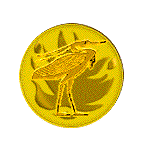
The original benben was "the primeval hill which, in Egyptian cosmology, first emerged from the waters of chaos to become Atum, the God of Creation". (3) This hints at its astronomical identity, especially as its period of return is measured in either hundreds, or even thousands of years.
The prominent archeo-astronomy scientist E.C. Krupp has linked the Phoenix with both the Sun and Sirius:
"The Egyptians
attached particular importance to a heron-like bird they called the "bennu",
and the Greeks identified the bennu with the phoenix. According to Herodotus,
the red and gold bennu was reported to return from Arabia to Heliopolis
after five hundred years’ absence, or, more curiously, according to others,
after 1,461 years. In some versions of the legend the bennu dies at heliopolis,
and from either its nest or its own burned remains a new bennu arises to
start the cycle of life anew."
(3)
The figure of 1,461 years is the length of time of the Sothic Cycle, the time taken for the Solar Calendar to coincide again with that of Sirius. (Sirius has a yearly cycle of 365 days compared with the Solar 365.25). This leads Krupp to identify the Phoenix with Sirius. But he recognises that things are not that simple, as the Phoenix also clearly has a solar dimension:
"The bennu must have been associated with the sun, for the bird, in Egyptian myth, was said to be the soul of Ra… Contradictory aspects of the myth of the bennu and the very idea of the benben have made it difficult to understand the relationship between these very important symbols and the Egyptian solar religion… The bennu was the guide of the gods in the Duat and came from the heart of Osiris." (3)
This confusion between
important stars and the Sun will be a running theme throughout our investigation.
It confuses Egyptologists and muddies the waters greatly. I strongly suspect
that the solution lies in the guise of a hitherto unknown celestial body,
that incorporates a mixed identity of star, planet and dark sun. This is
represented by the Phoenix, or Bennu, and symbolises its rebirth in the
heavens after a protracted absence. The Phoenix is associated with the
Sun and Sirius because its
visible perihelion
passage occurs near Sirius, and sometimes is cast into the darkness of
the Duat, emerging heliacally with the Sun. I will be showing how this
possibility explains the lack of evidence of Nibiru’s last passage, and
why the Egyptians held the heliacal setting and rising of Sirius to be
of such fundamental importance.
The Messianic Dragon
The symbolism of this "Messianic Dragon", which appears to underpin much of non-Judaeo/Christian mythology finds a startling corollary in the Dark Star Theory. After all, we have just been looking at the constellations of Aquila and Serpens, respectively the Eagle and Serpent. Combine these and you have a Flying Serpent, or dragon. Or the imagery of the Cenral American Quetzalcoatl. Now this appears almost comical to our minds, but I suspect it may have some grounding within this theory.
Horus can be identified with both the Messiah and a hawk, whilst his arch-enemy, Set, finds his symbolism connected with evil and serpents. Thus the Messianic Dragon implies a religious duality which finds an astronomical basis in the constellations. This is the opposite part of the sky to the Duat, and one could poetically term it the "Domain of the Dragon". These two constellations combine in the form of the dragon and denote the location of the brown dwarf when in the Oort Cloud. It’s counterpoint is the Duat, which is the region of the sky dominated by Sirius and Orion.

The Messianic Dragon emerges from this Domain once every 3400-3800 years, and its passage through the planetary portion of the Solar System has either catastrophic or evolutionary consequences for mankind. It is thus my contention that some of the world’s ancient mythology is allegorical, based upon the extremely rare and potentially catastrophic transit of Nibiru, the brown dwarf, with its retinue of moons and comets.
In a future posting, I will provide evidence that some of our most famous prophecies of the Apocalypse rely on the same imagery, implying that their basis lies in science, not religion or the occult. Is it possible that the writer of the Book of Revelation, and that most famous of seers, Nostradamus, were adepts of secret knowledge that spans the history of Man, and that their visionary works are warnings to us all based upon hidden, perhaps heretical, scientific knowledge?
However, before moving into this fascinating territory, we must first find the last perihelion passage, in order to help us to extrapolate Nibiru’s movements back into the past, and into the future.
Perihelion of the Divine Star
Sitchin initially proposed that Nibiru appeared in 3760BC, marking the beginning of the Nippurian calendar and the Jewish count of years (4). In later books he shifted his time-frame, but I tend to think that his initial idea was the correct one. He argues convincingly that this, and previous extrapolated passages of Nibiru, marked transition periods in Mankind’s development, essentially indicating input by the Annunaki.
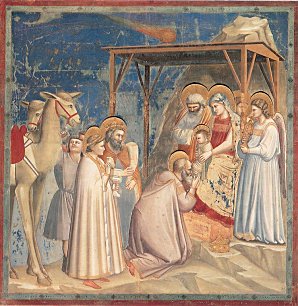
Also, the passage of about 11,000BC, which he points to as the date of the flood, fits well with Bauval’s theories (5) regarding the archeo-astronomical dating of the pyramid field at Giza (10,450BC), which marks the post-Diluvial reconstruction of the prehistoric world’s lost civilisation.
The problem is that, given the periodicity of 3600 years for Nibiru (a figure which is clearly an approximation for religious, magical or astrological reasons), there should be evidence of Nibiru’s appearance in the skies around 160BC. There isn’t, and this might explain Sitchin’s change of mind over the dating.
But when the periodicity is seen as a gross approximation to fit the religious mind-set of the Sumerian priests, then we can explore that historical period with a little more latitude. By far the best candidate is the Star of Bethlehem, classically thought to have appeared at the turn of the first millennium.
In setting out to discover an exact date for the appearance of Nibiru at this time, I discovered a number of uncomfortable problems. The Gospels do not provide evidence for the actual appearance of a new star, neither is there corroborating evidence in contemporary accounts.

In fact, Picknett and Prince in their book "The Templar Revelation" make a convincing case that the Nativity story is a mythological device added to the Gospels by the Early Church fathers, to give Jesus the air of divinity.
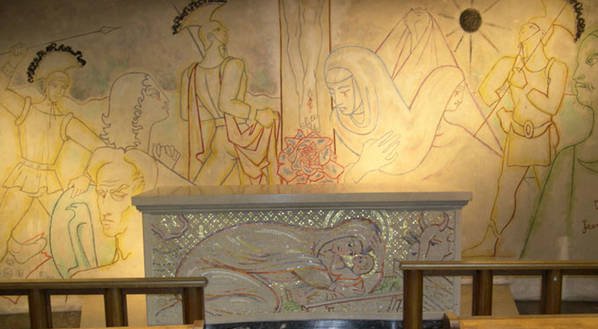
Furthermore, they identify Egyptian roots to the Christian mission, as well as heretical works of art placing a dark star at the scene of the crucifixion. A prime example of this is the mural depicting the crucifixion hanging in the church of Notre-Dame de France in London. The picture above was painted by Jean Cocteau, an alleged Grand Master of the supposed Priory of Sion. The depiction of the dark star is prominent, and does not have the appearance of a total eclipse as one might expect from the biblical account of the sky darkening at mid-day(6). I will be showing how this imagery is so important when I identify Nibiru's last appearance in DarkStar 8.
It seems likely to me that the upsurge in anticipation of the emergence of the Messiah at that time was triggered by something, quite possibly by the appearance of this fabled ‘star’.The appearance of the Messiah had been expected for a couple of centuries before the time of Christ, as explained by Bauval and Hancock:
"…in circa 330BC, when the vernal point was beginning its precessional drift into the ‘Age of Pisces’…the conquests of Alexander the Great (356-323BC), and the resulting merger of the Eastern and Western worlds, triggered great expectations of a messianic ‘Return’ in the East. First at Alexandria, then across the Levant, a great agitation began, as if triggered by some prophetic ‘device’, which culminated in the great messianic events of Christianity." (7)
If Sitchin’s initial claims about Sumerian mythology are to be believed, then the 12th Planet was due to appear around 160BC, 3600 years after the last Nibiruan appearance in 3760BC. Is it any wonder that the excitement about this event began as early as the time of Alexander the Great? After all, the figure 3600 serves only as an approximation, as Sitchin himself agrees:
"As to the 3,600 (Earth) years, I always stress that this is a mathematical number and that the actual orbit fluctuates, as Halley’s comet does on a smaller scale."(8)
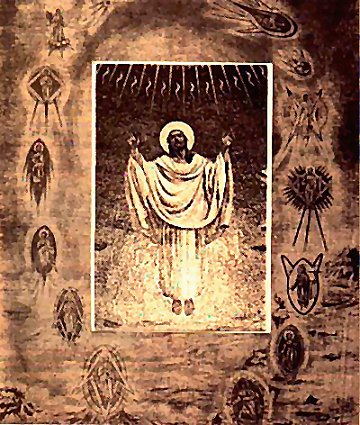
If the fluctuation is anything up to 200 years, then the Messiah’s ‘return in the East’ could have happened any time between about 350BC and 50AD.
In other words, the civilised peoples of Mesopotamia and Egypt, who incorporated the ‘Winged Disc’ into their religions, would have started to anticipate the coming of the Messianic Star during the time of Alexander the Great, as Bauval and Hancock claim.
The ‘agitation’ continued for well over 300 years, as many generations of people hoped for the return in vain. The length of this wait is itself remarkable, and signifies its importance and objective basis in reality. Eventually, this incredible wait was rewarded.
Nibiru was associated with ancient civilisations ruled by gods during the Zep Tepi, or ‘First Time’, and thereafter by Kings who were following the will and laws of the absent gods.
A promised return of a "King of the Jews" may well have referred to the promise of a return of Kingship on Earth when Nibiru next appeared.
Given that much of the world at that time was ruled by the Romans, who had no understanding of the Middle Eastern traditions of the Winged Planet, then it is natural to assume that the promised return to the rule of the ancient gods would amount to insurrection against the occupying forces of Rome. Hence why an emergent "King of the Jews" would capture the popular imagination of the down-trodden Egyptian world of that time. If the fabled Star returned as promised, then it would have given hope that the gods would return to end Roman rule, and re-establish the divine Kingship of old.
Bauval has provided an excellent case linking the Messianic Star with Sirius, including a comparison between early Christian mythology and the Egyptian Isis/Horus myths:
"Now the son of Osiris was the ‘divine child’ Horus born from the womb of the virgin-star goddess Isis, whose star was Sirius. The appearance of Sirius at rising was thus in Roman times very much still a potent symbol of divine birth and, more especially, of the birth of a messianic-like ‘king’ of solar pedigree." (9)
It should be pointed out that Bauval associates Osiris with Orion and Isis with Sirius, based upon the Pyramid texts and other analyses of the ancient Egyptian religion. In this sense, his understanding of the mythology is at odds with mainstream Egyptology, which rejects the idea of an ancient Egyptian Star cult, instead applying the universal Sun-god imagery to everything. Bauval and Hancock make an excellent case and have left Egyptology looking distinctly out of touch (10). Of course, Egyptologists would argue that it is not their wish to be in touch, necessarily. They would argue that alternative theories to explain Egyptian mythology are two-a-penny; but they are clearly rattled by the common-sense arguments outlined by these two ground-breaking researchers. I, for one, am firmly in the Bauval/Hancock camp.
Saying that, there’s one big problem with Bauval’s assertion that Sirius, itself, was the Messianic Star: Sirius is not a new star. However, it does point to the position in the sky that the Messianic Star must have been expected to appear, whilst showing the Egyptian roots of the Christian story. But what was Horus if Isis was identified with Sirius, and Osiris with Orion? Horus must represent the Messianic Star, born out of the stellar womb of Isis. In other words, a new star that appeared near Sirius!
It might come as a shock to many that a description of a very bright red star in Canis Major, during the time of Christ, is entirely verifiable. That a Roman text mentions this astronomical anomaly, and that the veracity of that text is beyond doubt. That astronomical researchers have tried, in vain, to explain this anomaly for centuries, yet have never once linked it with the Messianic Star! But before proposing this new solution to the problem of Nibiru's last appearance, it is necessary to dig deep into Egyptian mythology, and re-examine our understanding of the Duat within this context.
Continue to
DarkStar7
Written by
Andy
Lloyd,
8th August 2000
author of 'The Dark Star'
(2005), 'Ezekiel One'
(2009), 'The Followers of
Horus' (2010) and 'Darker Stars' (2019) Published by Timeless Voyager Press
References
1) Zecharia Sitchin "Genesis Revisited" p30, 324-328, 34 Avon Books, 1990
2) Laurence Gardner "Genesis of the Grail Kings: The Explosive Story of Genetic Cloning and the Ancient Bloodline of Jesus" Bantam 1999
3) E.C. Krupp "In Search of Ancient Astronomies" pp215-219 Penguin 1984
![]() In Search of Ancient Astronomies
In Search of Ancient Astronomies
4) Zecharia Sitchin "The Lost Realms" p 268 Avon Books, 1990
5) Robert Bauval and Adrian Gilbert "The Orion Mystery: Unlocking the secrets of the pyramids" p202 Mandarin 1994
6) Lynn Pickett and Clive Prince "The Templar Revelation: Secret Guardians of the True Identity of Christ " p46 Bantam Press 1997
7) Robert Bauval & Graham Hancock "Keeper of Genesis: A Quest for the Hidden Legacy of Mankind" p299 Mandarin 1996
8) Correspondence from Zecharia Sitchin, 12th July 2000
9) Robert Bauval "Secret Chamber: The Quest for the Lost Knowledge of Ancient Egypt" p318-331 Century 1999
10) Robert Bauval & Graham Hancock "Keeper of Genesis: A Quest for the Hidden Legacy of Mankind" Mandarin 1996
11) Ed. R. Story "The Encyclopaedia of Extraterrestrial Encounters" p282 New American Library 2001
![]() The Encyclopaedia of Alien Encounters
The Encyclopaedia of Alien Encounters